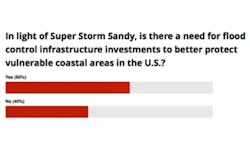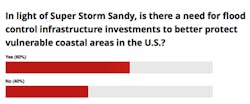A recent Flow Control Trendlines Poll asked: In light of Super Storm Sandy, is there a need for flood control infrastructure investments to better protect vulnerable coastal areas in the U.S.? Yes or No?
Sixty percent of respondents said "Yes," while 40 percent said "No."
New York’s city and regional planners and building developers seem to be in the "Yes" mindset two months after Sandy’s devastation. As reported by Environmental Leader, the NYS 2100 commission, appointed by New York governor Andrew Cuomo in Sandy’s aftermath, issued a draft report last week proposing changes to protect the area from future natural disasters that could harm utilities, railways, wastewater treatment facilities, and the coastline.
Some of the commission’s proposals include adding storm surge barriers to protect New York Harbor and adding "green infrastructure" features, such as dunes, wetlands, and oyster beds, to the state’s industrial shoreline to help infiltrate, evaporate, retain, or reuse storm water.
The preliminary report also calls for "more protection of petroleum, chemical and hazardous waste tanks located in flood plains, strengthening of wastewater and drinking water infrastructure, and decentralizing of electricity generation through more networks of cogeneration, combined heat and power, and solar power," the Environmental Leader reports.
According to The New York Times, the damage caused by Sandy has also prompted building developers to reassess design plans and add a number of "costly" improvements to prevent damage from future natural disasters.
Such improvements include extensive waterproofing, installing mechanical equipment on upper floors, and adding floodgates and backup generators, the New York Times reports. Owners of existing buildings are also undertaking expensive retrofits to protect their buildings and residents from flooding going forward.



